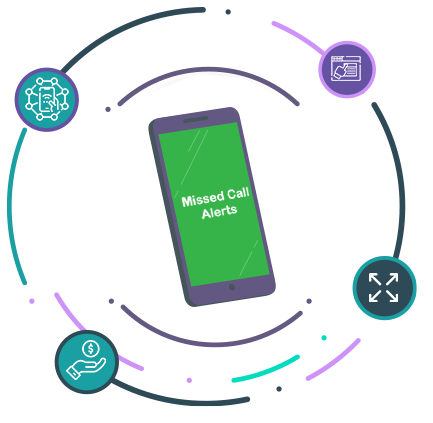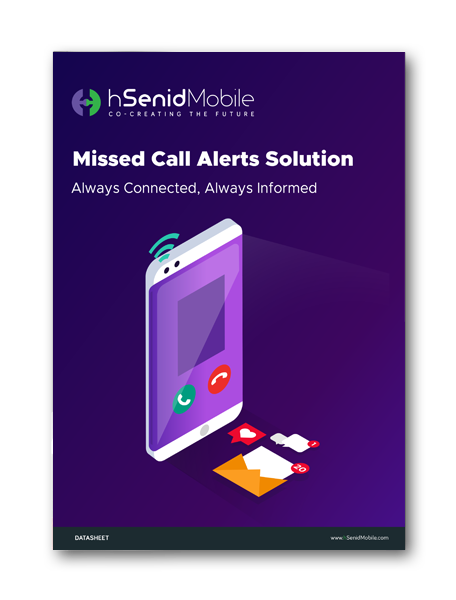Despite all our advanced tools and instant messaging platforms, people still miss calls that matter. Whether it’s due to poor signal, a dead battery, or being in another conversation, these missed calls can have serious consequences. They might lead to lost business opportunities, customer dissatisfaction, or even broken personal connections.
That’s where the Missed Call Alert (MCA) comes in. It may seem simple compared to flashy push notifications, but in many cases, it’s the more powerful and dependable communication tool. In an industry that celebrates complexity, this small but mighty feature often delivers the biggest impact.
Understanding the Power of the Missed Call Alert
A missed call alert (MCA) is one of the most reliable tools in a telecom operator’s portfolio. Unlike push notifications that rely on internet connectivity and app permissions, a missed call alert works purely through SMS. It notifies subscribers whenever they miss an incoming call because their phone was switched off, unreachable, or busy.
According to hSenid Mobile’s Missed Call Alerts solution, the system automatically detects missed calls and sends a detailed SMS with the caller’s number, time, and date. This ensures users can easily reconnect with the person who tried to reach them, creating a seamless communication experience.
It’s a service that doesn’t require data, doesn’t depend on smartphone apps, and doesn’t need user action to work. It simply works—every time, everywhere.
Push Notifications vs. Missed Call Alerts: A Reality Check
Push notifications have become the digital standard for engagement. They remind us about sales, app updates, deliveries, or breaking news. But the very thing that makes them work—data connectivity—is also their biggest weakness.
When users travel through low-signal areas or temporarily lose internet access, push notifications often fail to deliver on time. In contrast, missed call alerts function at the network level. They operate through SMS, which remains the most resilient communication channel in the world.
SMS messages have an impressive 98% delivery rate, while push notifications average only around 60%, especially on Android devices. For telcos and enterprises, that difference can define the customer experience.
The reliability of SMS makes MCA indispensable in markets where internet penetration is low or inconsistent. It guarantees that subscribers never lose touch, even when their data network fails.
The Hidden Power of Simplicity
The brilliance of a missed call alert lies in its simplicity. It doesn’t need a smartphone or mobile data to function. It reaches every type of user, from feature phone owners in rural areas to executives in major cities.
This universality is a big advantage for mobile operators seeking to provide value-added services across diverse audiences. While push notifications often get buried among dozens of app alerts, a missed call alert stands out. It represents real human intent. Someone wanted to reach you.
Unlike push notifications that people frequently disable, missed call alerts are rarely ignored. They demand attention because they carry emotional and practical importance. The immediacy of the message triggers action, leading to higher engagement rates and stronger communication continuity.
How hSenid Mobile’s Missed Call Alert Solution Works
hSenid Mobile’s Missed Call Alerts solution is designed to ensure no call goes unnoticed. The system works automatically, seamlessly integrating into existing telecom infrastructure.
Here’s how it functions:
- Call Detection: When the subscriber’s device is switched off, busy, or out of range, the system identifies the missed call in real time.
- Alert Generation: It instantly generates a message containing the caller’s number and time of call.
- SMS Delivery: The alert is sent to the subscriber through the network’s SMS center.
- User Reconnection: When the subscriber’s phone becomes available again, they can see who called and respond immediately.
The process is fully automated and requires no user intervention. According to the system diagram in hSenid Mobile’s MCA datasheet, the solution includes real-time URL forwarding, online reporting, and auto-reply features. This combination ensures accuracy, instant alerts, and scalable network performance for millions of subscribers.
Why Missed Call Alerts Drive Higher Engagement
- They are inherently personal. Every alert is tied to a specific action—a real person trying to connect.
- They inspire instant action. Users respond faster to missed call alerts than to push notifications. Studies show callback rates from MCA messages can exceed 45%, which is far higher than most digital campaigns.
- They build trust. SMS-based alerts are perceived as more authentic and secure, especially in regions where app-based notifications are frequently misused for scams.
- They are language-agnostic. hSenid Mobile’s solution supports multilingual alerts, allowing operators to send messages in the subscriber’s preferred language.
- They don’t rely on internet access. This ensures continuous communication, even in low-bandwidth areas.
A Business Advantage for Telecom Operators
- Customer Retention: Subscribers value reliability. When they know they’ll never miss a call, their loyalty to the operator strengthens.
- Reduced Customer Support Load: Automated alerts reduce the number of inquiries about missed calls or failed connections.
- New Revenue Streams: Operators can monetize the service through subscription models or premium VAS (Value Added Services) bundles.
- Enhanced Network Utilization: Each alert message leverages existing infrastructure, optimizing usage without additional strain.
When Simplicity Becomes Strategy
Sometimes, innovation means refining what already works. While advanced digital solutions capture attention, many users still crave reliability above all. In areas where data coverage fluctuates, or in developing markets where smartphones are not universal, MCA becomes a strategic tool for customer retention.
It’s not just about missed calls. It’s about ensuring continuity—making sure that every customer feels connected at all times. hSenid Mobile’s solution is built with scalability in mind, supporting millions of users while maintaining consistent performance.
With built-in integration support for existing network systems, deployment becomes quick and cost-effective. This simplicity makes MCA an attractive addition for operators looking to boost engagement without major capital expenditure.
Beyond Connectivity: The Emotional Layer
Unlike push notifications, missed call alerts communicate something more human. They represent intent and care. It’s not a generic “offer” or “reminder.” It’s a notification that says, “Someone tried to reach you.”
That small difference creates a big emotional impact. It drives people to respond, to reconnect, and to maintain their personal and professional relationships.
For brands, this means MCA can be leveraged as part of a customer relationship strategy. It ensures touchpoints remain active and that engagement is based on real communication rather than digital noise.
Real-World Applications
- Banking: Notify customers about important missed calls from relationship managers.
- Healthcare: Inform patients about calls from doctors or clinics.
- Retail: Ensure customer callbacks for support or delivery coordination.
- Government Services: Alert citizens about important outreach attempts.
Data Security and Scalability
Modern telcos require more than just functionality. They demand secure, scalable solutions that align with network architecture. hSenid Mobile’s MCA solution meets these expectations through advanced integration with the operator’s core signaling stack and SIGTRAN Gateway.
This ensures smooth communication across different network structures, faster deployment, and minimal downtime. The system is capable of handling massive traffic volumes, supporting both local and international operators.
For large-scale operators managing millions of subscribers, that scalability is crucial. It guarantees performance consistency as user bases grow and communication needs evolve.
Operational Efficiency and Cost Savings
Missed call alerts not only improve customer experience but also enhance internal efficiency. Automating the alert process reduces the need for manual intervention and support inquiries. Operators no longer have to handle large volumes of “call failed” complaints.
Moreover, since the service operates on existing SMS infrastructure, it doesn’t demand extensive new investment. It delivers measurable results at a fraction of the cost of developing and maintaining app-based push systems.
Building the Future of Reliable Communication
In an age where communication technologies evolve rapidly, the missed call alert stands as a reminder that reliability still wins. It is the bridge between high-tech innovation and everyday usability.
Telcos that adopt MCA are not only improving customer satisfaction—they’re future-proofing their networks. By providing consistent service even in low-connectivity environments, they demonstrate reliability that customers can trust.
As the telecom industry shifts toward 5G and beyond, this dependability will become a key differentiator.
Conclusion: The Power of Never Missing a Call
Push notifications may dominate the digital marketing landscape, but when it comes to real human connection, the missed call alert remains unmatched. It’s personal, reliable, and universally accessible.
hSenid Mobile’s Missed Call Alerts solution proves that technology doesn’t have to be complex to be powerful. By keeping subscribers informed and connected, it enhances customer satisfaction, reduces churn, and opens new revenue opportunities for telcos.
If reliability, engagement, and connectivity matter to your business, it’s time to look at how a missed call alert can reshape your communication strategy.
Learn more about hSenid’s Missed Call Alert Solution and discover how it can enhance communication efficiency for telecoms and enterprises worldwide.








